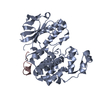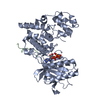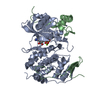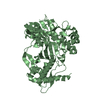Entry Database : PDB / ID : 5etaTitle Structure of MAPK14 with bound the KIM domain of the Toxoplasma protein GRA24 Mitogen-activated protein kinase 14 Putative transmembrane protein Keywords / / / / Function / homology Function Domain/homology Component
/ / / / / / / / / / / / / / / / / / / / / / / / / / / / / / / / / / / / / / / / / / / / / / / / / / / / / / / / / / / / / / / / / / / / / / / / / / / / / / / / / / / / / / / / / / / / / / / / / / / / / / / / / / / / / / / / / / / / / / / / / / / / / / / / / / / / / / / / Biological species Homo sapiens (human)Toxoplasma gondii (eukaryote)Method / / / Resolution : 2.8 Å Authors Pellegrini, E. / Palencia, A. / Braun, L. / Kapp, U. / Bougdour, A. / Belrhali, H. / Bowler, M.W. / Hakimi, M. Journal : Structure / Year : 2017Title : Structural Basis for the Subversion of MAP Kinase Signaling by an Intrinsically Disordered Parasite Secreted Agonist.Authors : Pellegrini, E. / Palencia, A. / Braun, L. / Kapp, U. / Bougdour, A. / Belrhali, H. / Bowler, M.W. / Hakimi, M.A. History Deposition Nov 17, 2015 Deposition site / Processing site Revision 1.0 Oct 26, 2016 Provider / Type Revision 1.1 Dec 7, 2016 Group Revision 1.2 Jan 18, 2017 Group Revision 1.3 Feb 20, 2019 Group / Data collection / Derived calculationsCategory pdbx_data_processing_status / pdbx_validate_symm_contact ... pdbx_data_processing_status / pdbx_validate_symm_contact / struct_conn / struct_conn_type Revision 1.4 Nov 13, 2024 Group / Database references / Structure summaryCategory chem_comp_atom / chem_comp_bond ... chem_comp_atom / chem_comp_bond / database_2 / pdbx_entry_details / pdbx_modification_feature Item / _database_2.pdbx_database_accession
Show all Show less
 Yorodumi
Yorodumi Open data
Open data Basic information
Basic information Components
Components Keywords
Keywords Function and homology information
Function and homology information Homo sapiens (human)
Homo sapiens (human)
 X-RAY DIFFRACTION /
X-RAY DIFFRACTION /  SYNCHROTRON /
SYNCHROTRON /  MOLECULAR REPLACEMENT / Resolution: 2.8 Å
MOLECULAR REPLACEMENT / Resolution: 2.8 Å  Authors
Authors Citation
Citation Journal: Structure / Year: 2017
Journal: Structure / Year: 2017 Structure visualization
Structure visualization Molmil
Molmil Jmol/JSmol
Jmol/JSmol Downloads & links
Downloads & links Download
Download 5eta.cif.gz
5eta.cif.gz PDBx/mmCIF format
PDBx/mmCIF format pdb5eta.ent.gz
pdb5eta.ent.gz PDB format
PDB format 5eta.json.gz
5eta.json.gz PDBx/mmJSON format
PDBx/mmJSON format Other downloads
Other downloads 5eta_validation.pdf.gz
5eta_validation.pdf.gz wwPDB validaton report
wwPDB validaton report 5eta_full_validation.pdf.gz
5eta_full_validation.pdf.gz 5eta_validation.xml.gz
5eta_validation.xml.gz 5eta_validation.cif.gz
5eta_validation.cif.gz https://data.pdbj.org/pub/pdb/validation_reports/et/5eta
https://data.pdbj.org/pub/pdb/validation_reports/et/5eta ftp://data.pdbj.org/pub/pdb/validation_reports/et/5eta
ftp://data.pdbj.org/pub/pdb/validation_reports/et/5eta Links
Links Assembly
Assembly


 Components
Components Homo sapiens (human) / Gene: MAPK14, CSBP, CSBP1, CSBP2, CSPB1, MXI2, SAPK2A / Production host:
Homo sapiens (human) / Gene: MAPK14, CSBP, CSBP1, CSBP2, CSPB1, MXI2, SAPK2A / Production host: 

 X-RAY DIFFRACTION / Number of used crystals: 1
X-RAY DIFFRACTION / Number of used crystals: 1  Sample preparation
Sample preparation SYNCHROTRON / Site:
SYNCHROTRON / Site:  ESRF
ESRF  / Beamline: ID23-2 / Wavelength: 0.873 Å
/ Beamline: ID23-2 / Wavelength: 0.873 Å Processing
Processing MOLECULAR REPLACEMENT / Resolution: 2.8→40.132 Å / SU ML: 0.54 / Cross valid method: FREE R-VALUE / σ(F): 1.97 / Phase error: 33.85 / Stereochemistry target values: ML
MOLECULAR REPLACEMENT / Resolution: 2.8→40.132 Å / SU ML: 0.54 / Cross valid method: FREE R-VALUE / σ(F): 1.97 / Phase error: 33.85 / Stereochemistry target values: ML Movie
Movie Controller
Controller













 PDBj
PDBj









